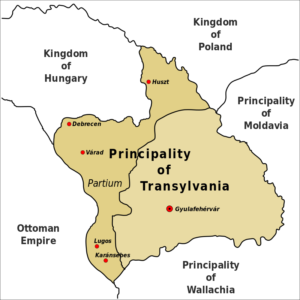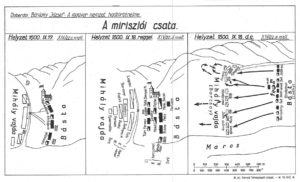The Long War, Part 25/ The Battle of Miriszló, 1600

General Basta defeats Voivode Mihail II at Miriszló, 18 September 1600
The troubles in the Transylvanian Principality, triggered by the unstable and tyrannic reign of Prince Báthori Zsigmond, have led to the fall of the country into German / Wallachian (Romanian) hands, as you could read in the previous part:

The Chief Captain of Kassa (Kosice, Kaschau) in the Habsburg-ruled Kingdom of Hungary, Giorgio Basta also set out towards Transylvania but instead of marching into the middle of the Principality, took the important castles on its Borderland. He was a renowned soldier and he knew his back had to be defended.

The Voivode accused Basta of being delayed because he had been bribed by Báthori András. Let me remark: late Báthori András, the one who was killed by the Székely troops of Voivode Michael was said to have wanted to bring Transylvania back to the Sultan’s side. It is obvious, that Basta was deeply hurt by the accusation and their later relationship with Michael has suffered this incident dearly.
Initially, Michael acted on behalf of King Habsburg Rudolf but gradually became more and more independent from him. The Wallachian nobles appeared in his court and he summoned Diets. He tried to balance himself between the Sublime Porte and Prague. When the envoys (Ungnad David and Székely Mihály) of King Rudolf arrived there to take over the country in the first part of 1600, Michael II demanded a very high price in exchange for it. He wanted to remain the Governor of Transylvania as long as he would live and later he demanded the title of a “Prince” as well. He also demanded to rule the two Romanian lands, Moldova and Wallachia, and the Partium region between Transylvania and Hungary, including further properties and castles, making claims for the territories that were still in the hands of the Turks, too.

King Rudolf answered on 12 September that he may remain governor until he died in Transylvania but only as his proconsul. In the meantime, during the spring the Voivode sent similar demands to the Sublime Port which sent him the symbols of princely power in answer to that.
During the spring, Voivode Michael II took back Moldova from Voivode Jeremias Mohila thus he established a loose personal union of these lands. This move has utterly angered the Polish, though.
Due to the increased taxes, the cost of hiring soldiers, and the favoritism of the Voivode towards the Wallachians, the Transylvanian nobles were getting suspicious and angry. They began to plot against him and Michael answered with force to put the mutiny down. There were two groups of conspirators, one of them was waiting for the help of King Rudolf, and the other was hoping for the return of Báthori Zsigmond who lived in exile. Finally, they joined forces against the Voivode.

It was to their advantage that Michael II was getting ready to evade a possible attack from Poland and was collecting soldiers. Under this excuse, the Hungarian rebels were gathering on the field of Keresztes, led by Csáky István. (Please, note that I use the Oriental name order for Hungarian names where family names come first.) Michael II summoned his army consisting of Wallachian (Romanian), Cossack, Serbian, and Hungarian Székely soldiers. Note, that the Székelys joined him in unity because Michael promised them to restore their liberties.

It was too late when he realized that the Hungarian nobles were gathering against him. He turned to Basta for help, but the rebels had also turned to Basta. The Chief Captain of Kassa moved against Michael II, following the instructions coming from Prague. The Habsburgs had had enough of the independence of the Voivode, they wanted to put an end to it. The German troops set out in September and they were joined by the rebels at Torda, on 14 September.

Basta brought 6,000 soldiers and the Transylvanians’ army was 12,000 men strong. There were 4 bigger and 8 smaller cannons, too. Michael II’s army was estimated of 22,000 people with 28-32 cannons. The two armies met at Miriszló, at the River Maros, not far from Gyulafehérvár (Alba Iulia). Let us remark that Basta appreciated the military value of the Hungarian Hajdú soldiers, and he had hired many of them. Basta’s army deployed in three lines. In the middle of the first line, there were 300 riflemen, on their right and left there were 1,500-1,500 Hungarian and Transylvanian Hussars.

Csáky Pál was in the second line with his 2000 riders. Johann Pezzen stood with his 1,500 German riflemen in the Third line. On his left, there was Basta with 4,000 infantrymen and 12 cannons and on his right side, there were Thököly Sebestyén and Bocskai István with 2,000 Hussars. Yes, as you can see Bocskai, later Prince of Transylvania still fought on the Habsburgs’ side. Here you can read more about him:
https://www.hungarianottomanwars.com/essays/prince-bocskai-istvan/
Voivode Michael II placed 4,000 Cossacks and Wallachians into his first line. There were 10,000 Hungarian Székelys in his second line, led by Sennyey Pongrác, Bodoni István, and Barcsay András.
He deployed his cannons between the first and the second line. In his third line, he deployed 4,000 Wallachian (Romanian), Serbian, and Székely soldiers, led by him personally. He left 3,000 Székelys in reserve and Michael placed his 800-men-strong Hungarian bodyguard unit behind them because he didn’t trust the Székelys. The Székelys were supporting him because they hoped to recover their ancient privileges. You can read more about these Hungarian border guards here:
https://www.hungarianottomanwars.com/essays/who-were-the-szekelys/

General Basta, according to his plan, pretended a withdraw to entice his enemies to the field. Csáky and the army of the general withdrew towards Décse and put Miriszló on fire. The voivode, thinking himself the victor, followed the retiring forces. The Transylvanian-Habsburg army took up new positions and deployed itself at Décse but now it was Basta himself who stood right behind the vanguard with a group of riders, 3,000 German infantrymen following him, with 1,500 Silesian riders on both sides of him. The Hungarian and the Transylvanian units lined up on the two wings.

Michael II was surprised but he organized his troops and launched an attack. The heavy cannon fire caused great losses to Basta’s army but they stood the fire firmly and launched their counter-attack.
The Germans broke the enemy lines in the middle while the Polish and the Cossacks were made to turn tail on the right wing.

Yet, the Székely soldiers of Michael II were resisting very stoutly, albeit many of them fell, and they lost 4-10,000 people. Basta’s losses were far fewer. The Cossack riders escaped by crossing the Maros River and they never returned to Transylvania.

Finally, Michael II lost Transylvania and withdrew to Fogaras castle. Then he ceded his wife and children as hostages to the General and left for Moldova. There he suffered further defeats from the combined Polish-Moldavian forces in more battles, then he was forced out of his own homeland, Wallachia, as well. The ambitious Voivode Michael II could find shelter in King Habsburg Rudolf’s court in Prague and could return to Transylvania only during the next year. It is a different story to tell how finally General Basta had him murdered not much later.

All in all, the mercenaries of Basta and Michael II devastated the land of Transylvania so much that contemporary writers called it a disaster. Let us not forget that most of the atrocities committed by Basta’s mercenaries are connected to his Hajdú soldiers. A few years later it was only Prince Bocskai who succeeded in making order in Transylvania, paving the way for Prince Bethlen’s and Prince Rákóczi’s work to make Transylvania the prosperous, independent, and strong “Fairy Garden” of Europe – until the next Habsburg intervention, at least.
Source: Szibler Gábor and some own research

Dear Readers, I can only make this content available through small donations or by selling my books or T-shirts.
If you like my writings, please feel free to support me with a coffee here:
You can check out my books on Amazon or Draft2Digital, they are available in hardcover, paperback, or ebook:
https://www.amazon.com/dp/198020490X
or at https://books2read.com/b/boYd81


My work can also be followed and supported on Patreon: Become a Patron!http://Become a Patron!


